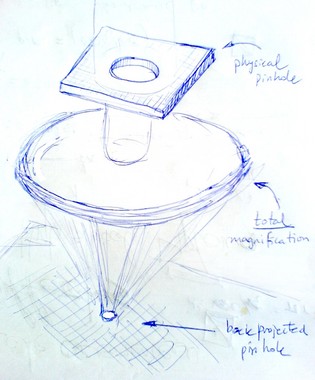Backprojected confocal pinhole calculator
A pinhole is a small hole used in Confocal Microscopes at the detection side of the lenses to get rid of out-of-focus light, thus allowing to record real 3D images.
The Huygens Deconvolution algorithms do not use the size of the physical pinhole, but the size of the pinhole Back Projected on the sample (expressed as a radius in nanometers).
Backprojected means as it appears imaged on the specimen plane: the physical pinhole size is divided by the total magnification of the detection system.
That's all! The backprojected radius is the real radius divided by the total magnification.
The total magnification is defined as the product of all the maginifications positioned between the disk and the specimen plane. In contrast to the Airy disc size, the backprojected pinhole size is independent of the wavelength being used. Acquisition software using an Airy disk value to set the pinhole size are often not really taking an experimental wavelength into consideration due to difficulties in determining which wavelength to use in computing the Airy disk size. Instead they use a fixed value, independent of the actual optical conditions.
(Using the backprojected pinhole radius establishes an uniform reference and avoids all kind of complexities concerning the imaging setup of the different microscope models. From the point of view of the PSF what matters is the image of the pinhole on the sample, not how this projection is technically achieved).

Why do we offer an online calculator? See some difficulties calculating the pinhole that we try to overcome with it.
Calculate the backprojected pinhole
The following forms will assist you in calculating the (circular-equivalent) backprojected pinhole radius expressed in nanometers, that you can directly use when Doing Deconvolution with the Huygens Software.
If you do not find your microscope model listed here, you can always contribute to improve this calculator by clicking in Report Other Microscope and sending us the necessary parameters.
Please begin by selecting your microscope model.
Leica
Zeiss
- Zeiss LSM410 inverted
- Zeiss LSM510
- Zeiss LSM700, LSM800 and LSM900
- Zeiss LSM710
- Zeiss LSM780, LSM880 and LSM980
Olympus
For the Olympus DSU (slit scanner) calculator see DiskScanningUnit
Nikon
- TE2000-E with the C1 scanning head
- TE2000-E with the C2 scanning head
- A1, A1 Plus, A1HD25, A1RHD25, AX, AXR
Visitech
Yokogawa CSU heads (spinning disk)
Andor (spinning disk)
Molecular Devices (spinning disk)
Not listed?
Is your microscope not listed and do you want it to be included here? Please read Report Other Microscope.
